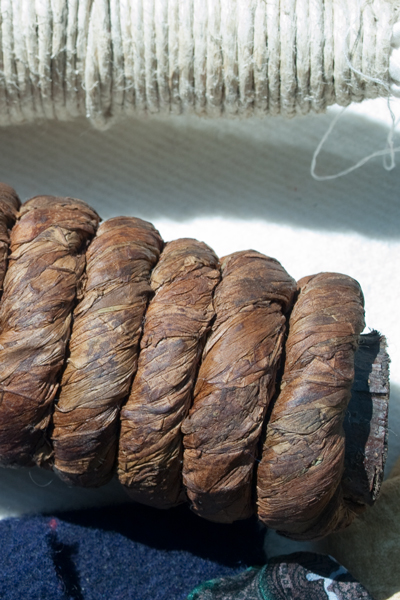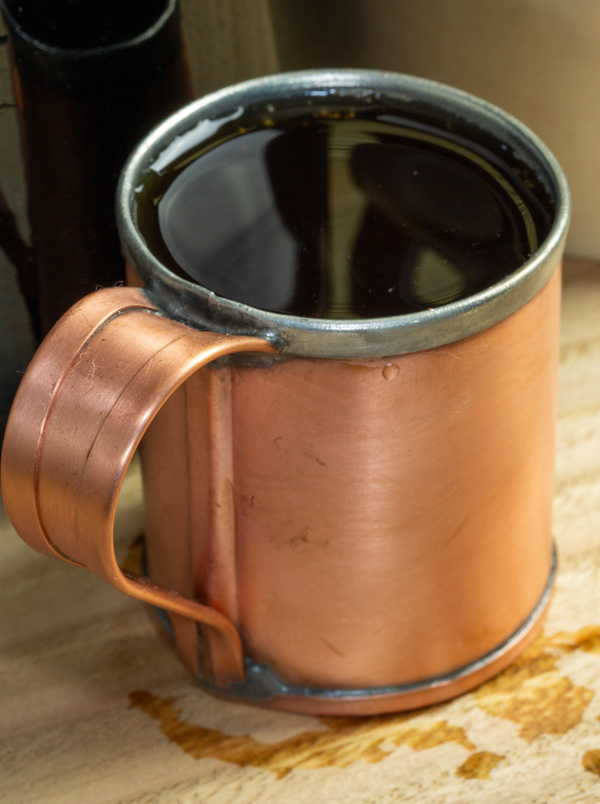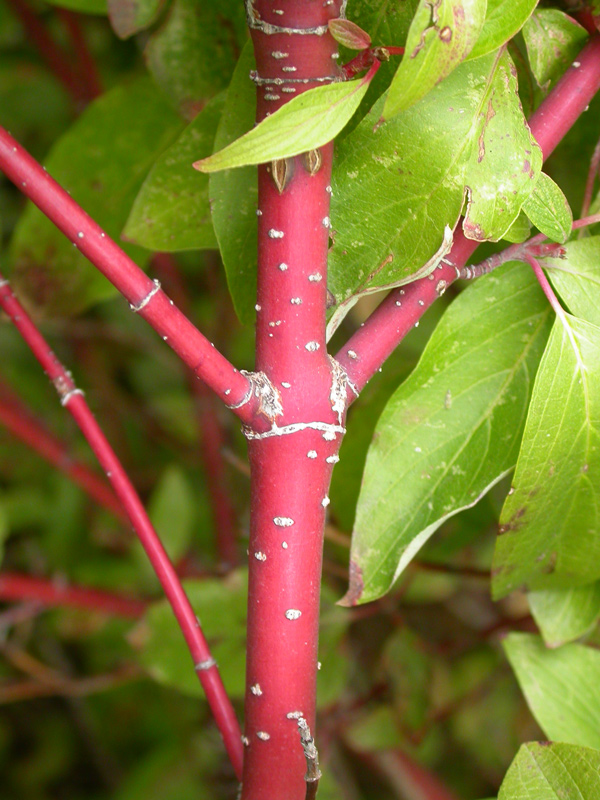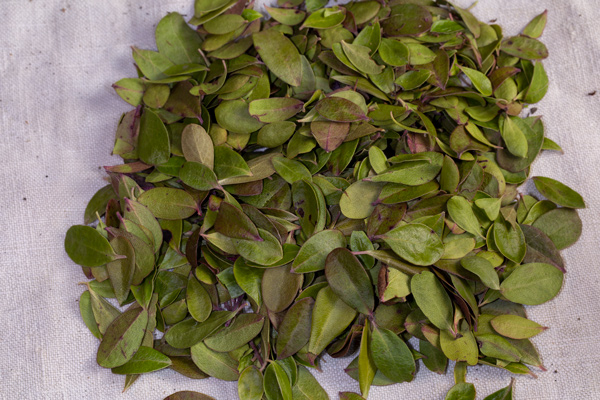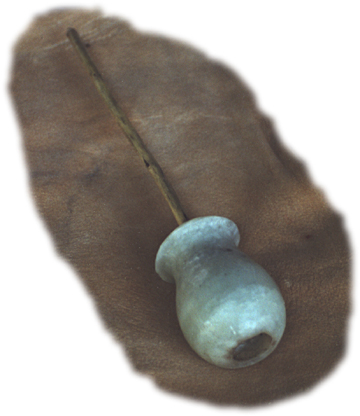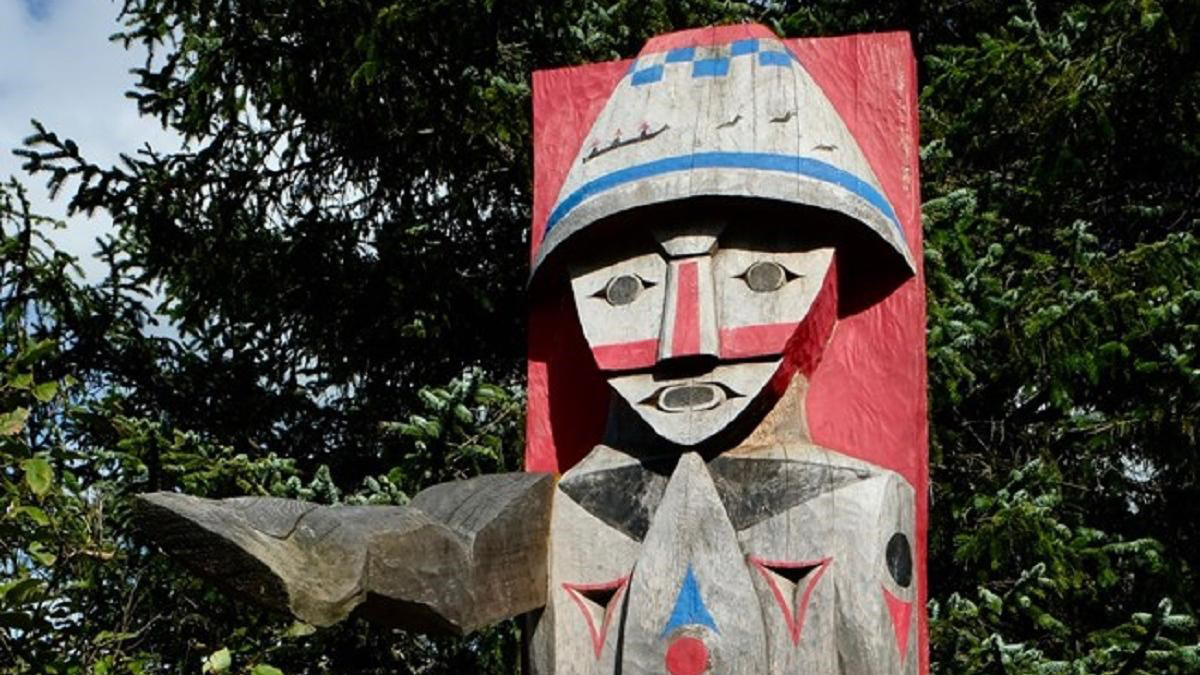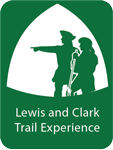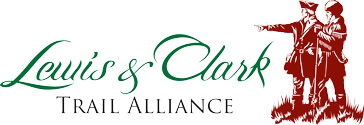Tobacco Carrot
Interpretation by John W. Fisher. Photo © 2010 by Kristopher K. Townsend. Permission to use granted under the Creative Commons Attribution-Share Alike 4.0 International license.
A tightly rolled, twisted bundle of tobacco leaves (Nicotiana tabacum), called a carrot, was convenient for chewers. A bite was called a “plug”.
By the time of the Lewis and Clark Expedition, smoking had become pervasive across North America whether that be for ceremony or addictive pleasure. Tobacco had become a currency, and Meriwether would need to provide his expedition with an ample supply. The leaf of choice was Nicotiana tabacum—the hybridized species introduced by Euro-American traders. The captains would have to ration their dwindling supplies, and the smokers would have to extend their tobacco with leaves and inner bark from local plants and trees. The captains would also learn the endless variety of ceremonies practiced when sharing a pipe the People they met.
Short Rations
It is a remarkable fact that Meriwether Lewis‘s planning for the expedition resulted in a surplus of four essential commodities: lead for bullets and powder to fire them, ink to write with and paper to write on. It was equally significant, as far as most of the men were concerned, that they ran short of tobacco and whiskey.
In spite of the captains’ judicious rationing, the men drank the last of their supply of whiskey on 4 July 1805, and some of them–almost certainly including Meriwether Lewis–must have rued that day, not knowing how long it would be before they could down another snort, and perhaps fearful of the effects the deprivation would produce in their minds and bodies.[1]The lack of liquor was a violation of military regulations. In 1802 Congress had raised the statutory ration from half a gill to a full gill of rum, brandy or whiskey per man per day. A … Continue reading On their way down the Columbia, Pvt. John Collins brewed a little beer from fermented camas bread. On 21 October 1805, William Clark said it had molded and soured “by being frequently wet”. Despite that, he pronounced it excellent, but evidently it wasn’t tried again—probably for lack of time.
From the Yellowstone River in late July 1806, Clark ordered Sgt. Nathaniel Pryor and two privates to go on ahead to the Knife River Villages with the company’s horses, and then to proceed to a trading post on the Assinniboine River in Canada. There he was, among other duties, to purchase from trader Hugh Heney “such articles as we may stand in need of.” Pryor’s shopping list included pepper, sugar, coffee or tea, handkerchiefs, a hat for Sgt. John Ordway, knives, flints, whiskey, and tobacco. Regrettably, the loss of all the horses in his charge prevented the detail from succeeding.[2]For more, see Pryor’s Mission.
On 6 September 1806, as the reunited Corps of Discovery was speeding down the Missouri River toward St. Louis, they met an outbound party of traders whose sympathetic leader gave them a gallon of whiskey, and after 429 uncomfortable and thirsty days, their dry spell was over.
The Daily Ration
© 2015 by Kristopher K. Townsend. Permission to use granted under the Creative Commons Attribution-Share Alike 4.0 International license.
Addictions
For all but seven members of the company, as many alcoholic smokers learn, nicotine proves to be a primary addiction, and the longing for it is often harder to bear than the thirst for alcohol. The link between the two drugs was clear to Benjamin Rush, the nation’s leading physician and unofficial surgeon general of the U.S. at the time, and Lewis’s medical mentor during preparations for the expedition. Dr. Rush held the opinion that both smoking and chewing tobacco were unhealthy because they always led to drunkenness.
Near the North and South Dakota border in October 1804, their Arikara hosts graciously gave the Corps some of their own fragrant tobacco which Frederick Pursh was soon (1813) to name Nicotiana quadrivalvis. The Indians of the Great Plains had acquired the plant from the far West long before Europeans landed on the Atlantic seaboard. But it was not nearly as potent a drug as the domestic Virginia variety, N. tabacum. Sgt. Gass was to remark in his journal that the Indian tobacco was good enough for smoking, but not much of a chew, which was the preference of most of the users in the Corps. The depth of the chewers’ torment is reflected in the journals from time to time. Nicholas Biddle, who edited the first edition of the journals, was told that at Fort Clatsop some of them chopped up smokers’ pipe stems to suck out the nicotine residue. On Christmas morning, 1805, the captains made the dreary day a little more festive by distributing a few carrots of tobacco among the users. The seven non-users received new handkerchiefs.
Upon departure from Fort Clatsop, the need for rationing was all the more urgent inasmuch as N. tabacum was extremely valuable for trade and diplomatic negotiations with the Indians. Lewis had to cut off the men’s rations entirely, which condemned them to “suffer much for the want of it.” When Clark and his contingent arrived back at Fortunate Camp on the Beaverhead River in July 1806, the addicts didn’t even take time to unsaddle their horses before clawing at the cache where they had stored some on the way out.
Red-osier Dogwood
Cornus sericea
Location: Bozeman, Montana. © 2006 by Matt Lavin. Permission to use granted under the Creative Commons Attribution-ShareAlike 2.0 Generic (CC-BY-SA 2.0) license.
Dried Bearberry Leaves
© 2014 by Kristopher K. Townsend. Permission to use granted under the Creative Commons Attribution-Share Alike 4.0 International license.
Substitutes and Extenders
Prior to contact, Native Americans smoked a wide variety of plant material in addition to their own cultivated tobaccos. (See Indian Tobacco.) Prior to the Lewis and Clark Expedition, a narrower canon of substitutes had been developed and documented with the arrival of fur trade.
One way of stretching tobacco was to mix tobacco with the leaves of bearberry (Arctostaphylos uva-ursi) or the inner back of certain trees such as wild crabapple (Malus sp.), chokecherry (Prunus sp.), red alder (Alnus rubra), or red-osier dogwood (Cornus sericea).[3]Note that all parts of the red osier dogwood can be toxic to humans. Given the original Delaware word meaning “mixture”, all these substitutes are sometimes called kinnikinnick. Most often, however, kinnikinnick is another name for bearberry.
Gathering and processing enough of the inner bark of the dogwood, chokecherry, or alder was a tedious job, and it may have been that tedium, as much as the result, which made the smoking mixture personally and spiritually potent. Ponder the proto-scientific experiments that resulted in the discovery of which part of which plants, out of thousands upon thousands of different species, would help to improve the taste tobacco.
On 26 March 1806, three days after leaving Fort Clatsop, William Clark—known to be a prolific smoker—remarked:
our men who have been acustomed to the use of this article [tobacco], and to Whome we are now obliged to deny the use of this article appear to Suffer Much for the want of it. they Substitute the bark of the wild Crab which they Chew; it is very bitter and they assure me they find it a good Substitute for tobacco. the Smokers Substitute the iner bark of the redwillow and the saccommis [bearberry].
None of the substitutes they used contain any nicotine, but the crab apple bark was sufficiently bitter and the other two were adequately aromatic to suitably serve as placebos. A typical formula for a smoking mixture in the Pacific Northwest might consist of equal parts of dried bearberry leaf, the inner bark of red osier dogwood, sagebrush leaves (Artemisia sp.); the inner bark of the chokecherry, and the inner bark of any one of several species of alder. [4]Terry Willard, Edible and Medicinal Plants of the Rocky Mountains and Neighbouring Territories (Calgary, Alberta: Wild Rose College of Natural Healing, 1992), 164–65.
A Shoshone Smoking Lesson
The Ceremony
The captains were well aware that they needed to follow diplomatic protocols when smoking with their hosts. During a council with the Shoshone, for example, he explained why he attended barefoot:
the cerimony of our council and smoking the pipe was in conformity of the custom of this nation perfomed bearfoot. on those occasions points of etiquet are quite as much attended to by the Indians as among scivilized nations.[5]17 August 1805, Journals, Moulton, 5:112.
Days earlier, Lewis was given a lesson in smoking protocol, by Chief Cameahwait. The day, 13 August 1805, was an exceptionally full and fateful day, even for Meriwether Lewis. It really started off with a chance meeting with an old Lemhi Shoshone woman, which made up for all the weeks of growing anxiety and frustration. But it was when Cameahwait took him into the shelter of the only leather lodge his people had been able to save from the Hidatsas‘ depredations of the previous spring, that he knew for sure he was among good friends.
the Chief then lit his pipe at the fire kindled in this little magic circle, and standing on the oposite side of the circle uttered a speach of several minutes in length at the conclusion of which he pointed the stem to the four cardinal points of the heavens first beginning at the East and ending with the North. he now presented the pipe to me as if desirous that I should smoke, but when I reached my hand to receive it, he drew it back and repeated the same cremony three times, after which he pointed the stem first to the heavens then to the center of the magic circle smoked himself with three whifs and held the pipe untill I took as many as I thought proper; he then held it to each of the white persons and then gave it to be consumed by his warriors.
The Pipe
Lewis took especial notice of Cameahwait’s pipe:
this pipe was made of a dense simitransparent green stone very highly polished about 2½ inches long and of an oval figure, the bowl being in the same direction with the stem. a small piece of birned clay is placed at the bottom of the bowl to seperate the tobacco from the end of the stem and is of an irrigularly rounded figure not fitting the tube purfectly close in order that the smoke may pass. this is the form of the pipe.
Possibly the “simitransparent green stone” was what is today called talc, a magnesium silicate which in its purest form is called steatite (from the Greek word for tallow), or soapstone. It is among the softest of all minerals, and has been used since ancient times for carving utensils and ornaments. The Shoshones probably mined it from the mountains drained by the Ruby River, the stream Lewis named “Philanthropy,” after one of the cardinal virtues of Freemasonry.[6]Today, talc is an essential ingredient in the ceramic cores of catalytic converters, and also is used in the manufacture of dusting powders, lubricants, roofing materials, plastics, paper, and paint. … Continue reading
In a somewhat garbled note, Clark records a related exchange with Cameahwait:
This nation Call themselves Cho-shon-nê the Chief is name Too-et-te-con’l Black Gun is his war name Ka-me-ah-wah— or Come & Smoke. this Chief gave me the following name and pipe Ka-me-ah-wah.
Perhaps Cameahwait gave Clark the same green stone pipe that had earlier attracted Lewis’s attention, perhaps not. Cameahwait and Clark may have exchanged names or perhaps Cameahwait named Clark Kim-ah-pawn Shoshone for “Come and Smoke”.[7]Journals, Moulton 5:115–116 and n5, John E. Rees, “The Shoshoni Contribution to Lewis and Clark”, Idaho Yesterdays 2 (Summer 1958): 2–13. Despite his lack of clarity, there is no doubt a significant ritual had taken place.
The Tobacco
We can imagine Lewis asking for a closer look at the tobacco in Caheahwait’s pouch, rubbing a bit of it between his fingers, and directing Drouillard to sign a couple of questions to Cameahwait. A flurry of deadpan gestures are handed back and forth, back and forth. Drouillard translates them for Lewis into an English richly flavored with Canadian French, Shawnee, and creole patois. Whatever the exchange, Lewis managed to identify the tobacco:
their tobacco is of the same kind of that used by the Minnetares [Hidatsas] Mandans and ricares [Arikaras] of the Missouri. the Shoshonees do not cutivate this plant, but obtain it from the Rocky mountain Indians [Crows] and some of the bands of their own nation who live further south.
Chinookan “sounding proofs”
Smoking practices and rituals varied by Nation and many were unique to the individuals within them. One practice worthy of notice occurred while wintering over at Fort Clatsop. Lewis described their neighbors’ peculiar fondness for smoking:
The Clatsops Chinnooks [Washington Chinooks] and others inhabiting the coast and country in this neighbourhood, are excessively fond of smoking tobacco. In the act of smoking they appear to swallow it as they draw it from the pipe, and for many draughts together you will not perceive the smoke which they take from the pipe. In the same manner also they inhale it in their lungs untill they become surcharged with this vapour when they puff it out to a great distance through their nostils and mouth; I have no doubt the smoke of the tobacco in this manner becomes much more intoxicating and that they do possess themselves of all it’s virtues in their fullest extent; they freequently give us sounding proofs of it’s creating a dismorallity of order in the abdomen, nor are those light matters thought indelicate in either sex, but all take the liberty of obeying the dictates of nature without reserve.[8]8 January 1806, Journals, Moulton, 6:179.
Those “sounding proofs” must have greatly amused the American visitors—almost any 12-year-old boy will happily demonstrate the consequence of swallowing lots of air. In fact, when the use of tobacco was introduced into Europe–for its “medicinal” properties, believe it or not–the verb that described its consumption was “to drink,” the present one, “to smoke” arriving late in the 17th century.
Conclusion
Tobacco is still a central ingredient in Indian cultural traditions and sacred rituals, but the price of addiction to the commercial Turkish species—diabetes, emphysema, heart problems and cancers—has clearly become too high to tolerate any longer. According to statistics published by the Centers for Disease Control and Prevention, 4.1 Indians out of every 100,000 in the Southwest die from lung cancer caused by smoking; the rate among Indians in Montana and Wyoming is seven times higher, at 28.5 deaths per 100,000. Tribal health-care officials throughout the country currently are participating in the Indian Health Board’s In-Care Network program called “Beyond the Pipe,” which aims toward replacing Marlboros, Winstons, and the like with some of the old ceremonial mixtures—blends of wild herbs such as bearberry, mullein (Verbascum thapsus), red-osier dogwood bark, and yerba santa (Eriodictyon californicum).
Reflecting on their encounters with Native Americans, it is clear that the rituals surrounding tobacco were far more than mere habit—they were woven deeply into the social and cultural fabric of their communities. The unique methods of consumption and the openness with which these customs were practiced shed light not only on differing attitudes toward tobacco, but also on broader notions of propriety and communal life. Ultimately, such glimpses into everyday moments remind us that the exchange of goods like tobacco was also an exchange of traditions and worldviews, leaving a legacy that continues to shape cultural identities today.
Notes
| ↑1 | The lack of liquor was a violation of military regulations. In 1802 Congress had raised the statutory ration from half a gill to a full gill of rum, brandy or whiskey per man per day. A “gill” is one-fourth of a pint, or four fluid ounces. By the modern standards of the American Medical Association and the National Safety Council, four ounces of whiskey results in a blood alcohol level of 0.10 percent, at which point the consumer is legally intoxicated, and is prohibited from operating a motor vehicle. See on this site Alcohol Rations by Robert R. Hunt. |
|---|---|
| ↑2 | For more, see Pryor’s Mission. |
| ↑3 | Note that all parts of the red osier dogwood can be toxic to humans. |
| ↑4 | Terry Willard, Edible and Medicinal Plants of the Rocky Mountains and Neighbouring Territories (Calgary, Alberta: Wild Rose College of Natural Healing, 1992), 164–65. |
| ↑5 | 17 August 1805, Journals, Moulton, 5:112. |
| ↑6 | Today, talc is an essential ingredient in the ceramic cores of catalytic converters, and also is used in the manufacture of dusting powders, lubricants, roofing materials, plastics, paper, and paint. Soapstone is sometimes used to make sinks and countertops. |
| ↑7 | Journals, Moulton 5:115–116 and n5, John E. Rees, “The Shoshoni Contribution to Lewis and Clark”, Idaho Yesterdays 2 (Summer 1958): 2–13. |
| ↑8 | 8 January 1806, Journals, Moulton, 6:179. |
Experience the Lewis and Clark Trail
The Lewis and Clark Trail Experience—our sister site at lewisandclark.travel—connects the world to people and places on the Lewis and Clark Trail.
Discover More
- The Lewis and Clark Expedition: Day by Day by Gary E. Moulton (University of Nebraska Press, 2018). The story in prose, 14 May 1804–23 September 1806.
- The Lewis and Clark Journals: An American Epic of Discovery (abridged) by Gary E. Moulton (University of Nebraska Press, 2003). Selected journal excerpts, 14 May 1804–23 September 1806.
- The Lewis and Clark Journals. by Gary E. Moulton (University of Nebraska Press, 1983–2001). The complete story in 13 volumes.
